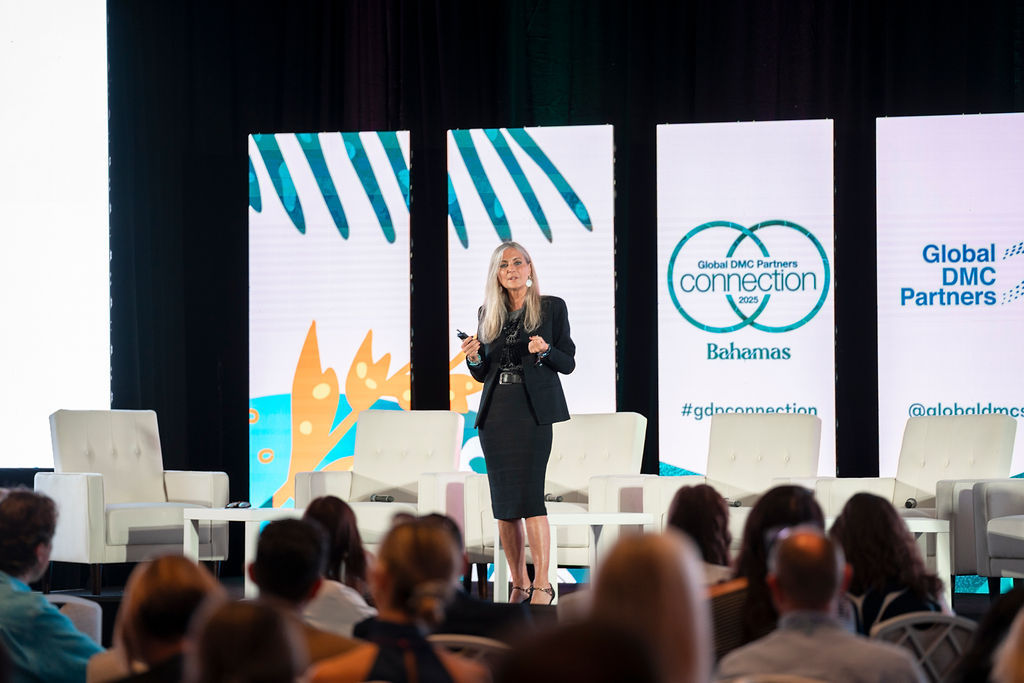The MICE sector is predicted to experience robust growth over the next decade, but uncertainty is peaking, and lead times are shorter than ever in 2025, making forecasting very difficult, according to Global DMC Partners president and CEO Catherine Chaulet.
In her opening keynote at GDP’s annual Connection event in The Bahamas, Chaulet said that the MICE industry is very solid, with a strong projected compound annual growth rate through 2033, despite current uncertainties. This growth is driven by an expected 59% increase in business tourism and greater globalisation, leading corporations to travel and meet.
The value of MICE events
She noted that MICE events bring more money and higher margins to destinations compared to low-margin leisure tourism, which can drain local resources, making the sector critical for the actual growth and support of local economies.
The MICE industry contributed 10% to the overall global GDP in 2024, projected to grow to 11.5%. Asia-Pacific holds the largest MICE market share at 40%, followed by North America (30%), Europe (20%), and the Middle East and Africa (10% and growing rapidly).
Additionally, over 58% of all international deals are initiated through MICE events, highlighting their direct impact on business success. Chaulet said the industry needs to improve in reporting financial metrics (e.g., specific deals made) to CEOs and CFOs to justify and secure larger program budgets.
Challenges for meeting planners
More than half (53%) of meeting planners are rescheduling events due to political or unforeseen crises, with geopolitical situations causing postponements from 2025 to 2026, and over half report that inflation and cost unpredictability are impeding long-term planning.
“Tariffs, for example, make it difficult to forecast. It’s not just about high costs, it’s that you don’t know if those costs will stay the same next month.”
While inflation is trending downward in many countries, Chaulet warned that headline figures often obscure the true impact on the events world. “Inflation for airlines, hotels, food and beverage is so much more in our world. The prices of the components of our programs are skyrocketing.”
Her advice to planners: arm yourself with industry-specific cost data when speaking to finance teams. “Sometimes when you speak with your CFO, they will look at macroeconomic inflation and think you should be able to negotiate. But our reality is very different.”
Despite concerning overall trends, Q1 and Q2 bookings in 2025 were on par with 2024, but most were decided very last minute (2-3 weeks to 1-2 months out), even for large programs. This makes future projections, even in the short term e.g., for Q3 and Q4, extremely challenging.
Top event destinations
Chaulet also shared the top destinations for MICE business in 2025. In the U.S., this includes major cities with large conference centres and hotel capacities such as Chicago, Washington D.C., Dallas, Las Vegas, Orlando, Denver, Boston, Hawaii, Austin, Atlanta, Nashville, San Antonio, and Miami.
Meanwhile, the top international destinations are Paris, Amsterdam, Madrid, Barcelona, London, Milan, Rome, Berlin, Lisbon, Copenhagen, Dubai, Bangkok, Singapore, Vienna, and Istanbul. Mexico (combining cities like Puerto Vallarta, Cancun) is also a significant international destination.
Chaulet also noted growing interest in “secondary destinations” that offer cost efficiency and fresh experiences.
There has been a dramatic drop in international travellers coming to the U.S., particularly from Canada (down 40% leisure), Europe (down 17%), and Mexico (down 23%), largely due to terrorist discussions and visa issues.
Other topics covered in the keynote and panel discussion that followed included generational preferences for events, the increasing role of technology and AI, and the growing importance of sustainability in the industry.
Check out the highlights and pictures from GDP Connection 2025 in The Bahamas

